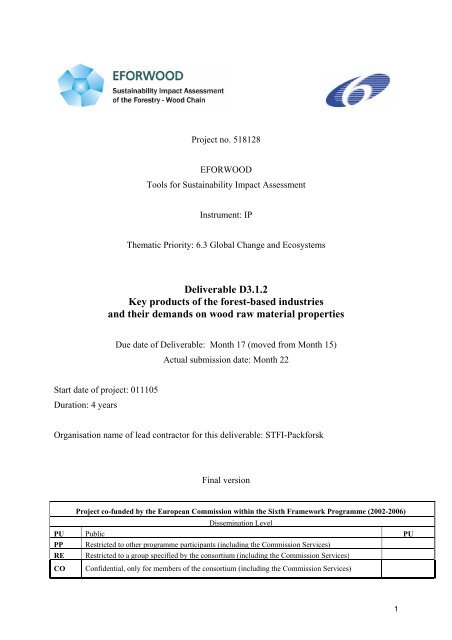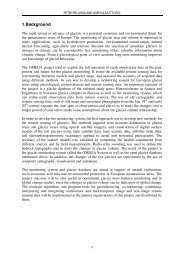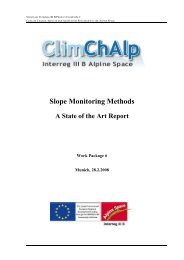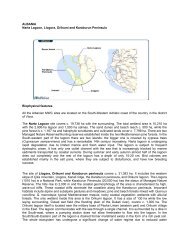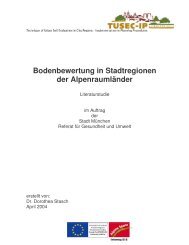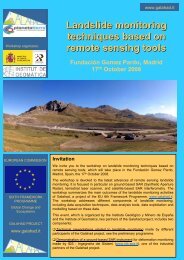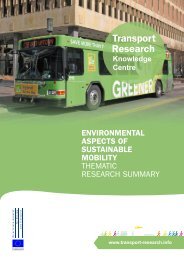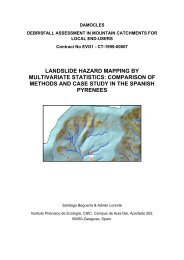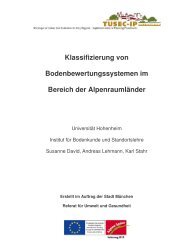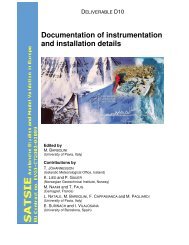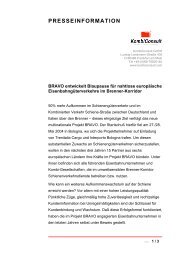Deliverable D3.1.2 Key products of the forest-based industries and ...
Deliverable D3.1.2 Key products of the forest-based industries and ...
Deliverable D3.1.2 Key products of the forest-based industries and ...
You also want an ePaper? Increase the reach of your titles
YUMPU automatically turns print PDFs into web optimized ePapers that Google loves.
Project no. 518128EFORWOODTools for Sustainability Impact AssessmentInstrument: IPThematic Priority: 6.3 Global Change <strong>and</strong> Ecosystems<strong>Deliverable</strong> <strong>D3.1.2</strong><strong>Key</strong> <strong>products</strong> <strong>of</strong> <strong>the</strong> <strong>forest</strong>-<strong>based</strong> <strong>industries</strong><strong>and</strong> <strong>the</strong>ir dem<strong>and</strong>s on wood raw material propertiesDue date <strong>of</strong> <strong>Deliverable</strong>: Month 17 (moved from Month 15)Actual submission date: Month 22Start date <strong>of</strong> project: 011105Duration: 4 yearsOrganisation name <strong>of</strong> lead contractor for this deliverable: STFI-PackforskFinal versionProject co-funded by <strong>the</strong> European Commission within <strong>the</strong> Sixth Framework Programme (2002-2006)Dissemination LevelPU Public PUPP Restricted to o<strong>the</strong>r programme participants (including <strong>the</strong> Commission Services)RE Restricted to a group specified by <strong>the</strong> consortium (including <strong>the</strong> Commission Services)CO Confidential, only for members <strong>of</strong> <strong>the</strong> consortium (including <strong>the</strong> Commission Services)1
<strong>Key</strong> <strong>products</strong> <strong>of</strong> <strong>the</strong> <strong>forest</strong>-<strong>based</strong> <strong>industries</strong><strong>and</strong> <strong>the</strong>ir dem<strong>and</strong>s on wood raw material propertiesPartners involved <strong>and</strong> acknowledgementThis report, deliverable <strong>D3.1.2</strong>, has been produced within <strong>the</strong> EFORWOOD workpackage 3.1 “QualityAssessment <strong>and</strong> Allocation”. The responsible organization has been STFI-Packforsk.Editor <strong>of</strong> <strong>the</strong> report was Sven-Ol<strong>of</strong> Lundqvist, STFI-Packforsk, who was also responsible for <strong>the</strong> partrelated to fibres, pulp <strong>and</strong> paper. Barry Gardiner, Forest Research, was responsible for <strong>the</strong> partsrelated to solid wood/wood-<strong>based</strong> panels <strong>and</strong> bio-energy.O<strong>the</strong>r contributing researchers are: Andy Hall (Forest Research), Martin Johansson (STFI-Packforsk),<strong>and</strong> Franka Brüchert (Baden-Württemberg Forest Research Institute)The editor wishes to acknowledge <strong>the</strong> Swedish-Finnish research programme “Wood Material Science<strong>and</strong> Engineering” <strong>and</strong> <strong>the</strong> funding parties <strong>of</strong> <strong>the</strong> Innovood project, from which parts <strong>of</strong> <strong>the</strong> backgroundmaterial regarding raw material dem<strong>and</strong>s <strong>of</strong> paper <strong>products</strong> have been obtained.Thanks are also due to experts in <strong>the</strong> paper industry <strong>and</strong> at STFI-Packforsk who have contributed withvaluable input.2
<strong>Key</strong> <strong>products</strong> <strong>of</strong> <strong>the</strong> <strong>forest</strong>-<strong>based</strong> <strong>industries</strong><strong>and</strong> <strong>the</strong>ir dem<strong>and</strong>s on wood raw material propertiesTable <strong>of</strong> contentsPageAcknowledgement 21. Summary 42. Introduction 42.1 Objective 42.2 <strong>Key</strong> <strong>products</strong> 42.3 <strong>Key</strong> properties 52.4 Quantitative <strong>and</strong> qualitative dem<strong>and</strong>s 53. Fibre chains 73.1 <strong>Key</strong> <strong>products</strong> 73.2 <strong>Key</strong> dem<strong>and</strong>s on wood <strong>and</strong> fibres 73.3 CPA codes 164. Solid wood <strong>and</strong> wood-<strong>based</strong> <strong>products</strong> 184.1 <strong>Key</strong> <strong>products</strong> 184.2 <strong>Key</strong> dem<strong>and</strong>s on solid wood 184.3 <strong>Key</strong> dem<strong>and</strong>s on logs 205. Bio-energy chains 285.1 <strong>Key</strong> <strong>products</strong> 285.2 <strong>Key</strong> dem<strong>and</strong>s on manufactured <strong>products</strong> in bio-energy chain 296. Quality-<strong>based</strong> allocation <strong>of</strong> wood raw materials to key <strong>products</strong><strong>and</strong> analysis <strong>of</strong> sustainability effects323
<strong>Key</strong> <strong>products</strong> <strong>of</strong> <strong>the</strong> <strong>forest</strong>-<strong>based</strong> <strong>industries</strong><strong>and</strong> <strong>the</strong>ir dem<strong>and</strong>s on wood raw material properties1. SummaryThe scope <strong>of</strong> this report is to express <strong>the</strong> dem<strong>and</strong>s on wood <strong>and</strong> fibres for selected <strong>products</strong> frommajor production lines in terms <strong>of</strong> raw material properties. The major production lines are divided intosolid wood chains, fibre chains <strong>and</strong> bio-energy chains. For each type <strong>of</strong> chains, sets <strong>of</strong> key producttypes have been identified.Properties <strong>of</strong> importance for <strong>the</strong>se product types have been listed. When possible, threshold valueshave been given. The plan is to revise <strong>the</strong> report later during <strong>the</strong> EFORWOOD project when moreinformation on threshold values can be introduced.In many cases, it is, however, not possible to state generally applicable threshold values, as <strong>the</strong>re arealternatives. If <strong>the</strong> available raw material is not suitable, it may be possible to investment in order tomake use <strong>of</strong> ano<strong>the</strong>r material. In particular, <strong>the</strong>se issues are very common for <strong>the</strong> fibre chains. In<strong>the</strong>se cases, <strong>the</strong> dem<strong>and</strong>s have to be expressed in more qualitative terms <strong>and</strong> <strong>the</strong> text <strong>of</strong> <strong>the</strong> report iswritten to provide a background to <strong>the</strong> preference for certain raw materials. Preferred values are onlyindicated ra<strong>the</strong>r than stated.The tables <strong>of</strong> key <strong>products</strong> have already proven to be useful, in connection with <strong>the</strong> establishment <strong>of</strong><strong>the</strong> layout <strong>of</strong> <strong>the</strong> Iberian case.2. Introduction2.1 ObjectiveThe objective <strong>of</strong> <strong>the</strong> deliverable <strong>D3.1.2</strong> within <strong>the</strong> workpackage 3.1 “Quality Assessment <strong>and</strong>Allocation” <strong>of</strong> module 3 was defined as:• To express <strong>the</strong> dem<strong>and</strong>s on wood <strong>and</strong> fibres for selected <strong>products</strong> in major production lines(solid wood to wood <strong>products</strong>, fibres to pulp <strong>and</strong> paper <strong>products</strong>, bio-energy) in terms <strong>of</strong> rawmaterial properties.To do this, it is obviously necessary to clearly define <strong>the</strong> <strong>products</strong> selected. Therefore, <strong>the</strong> deliverablehas been exp<strong>and</strong>ed to include <strong>the</strong> task <strong>of</strong>:• Defining <strong>the</strong> key <strong>products</strong> <strong>of</strong> <strong>the</strong> major production chains <strong>of</strong> <strong>forest</strong> <strong>based</strong> <strong>industries</strong> <strong>and</strong> <strong>the</strong>materials processed along each production chains.2.2 <strong>Key</strong> <strong>products</strong>The ambition has been to identify sets <strong>of</strong> key <strong>products</strong> for <strong>the</strong> major production chains, which arehereafter referred to as:• solid wood chains• fibre chains• bio-energy chains4
<strong>Key</strong> <strong>products</strong> <strong>of</strong> <strong>the</strong> <strong>forest</strong>-<strong>based</strong> <strong>industries</strong><strong>and</strong> <strong>the</strong>ir dem<strong>and</strong>s on wood raw material propertiesThe ambition has not been to list all possible <strong>products</strong> produced in all countries, but ra<strong>the</strong>r <strong>the</strong> key<strong>products</strong> or types <strong>of</strong> <strong>products</strong> <strong>of</strong> <strong>the</strong> different production chains. The ambition has been to defineproduct types covering at least 80 % <strong>of</strong> <strong>the</strong> production within Europe as a whole, so that <strong>the</strong> listedproduct types will cover at least 60-80 % <strong>of</strong> <strong>the</strong> production for <strong>the</strong> regions in which ToSIA, <strong>the</strong> Tool forSustainability Impact Assessment, is foreseen to be used within <strong>the</strong> EFORWOOD project <strong>and</strong>afterwards. Ano<strong>the</strong>r ambition has been to aggregate <strong>the</strong> types <strong>of</strong> <strong>products</strong> to a limited set which ispossible to relate to available statistics on consumption, production, import, export, etc.The selection <strong>of</strong> <strong>the</strong> key <strong>products</strong> has been performed in cooperation with experts engaged in relatedtasks within Modules 4 <strong>and</strong> 5. The starting point has been to identify <strong>the</strong> main types <strong>of</strong> converted<strong>products</strong> used by <strong>the</strong> end-user, such as books, sacks, outdoor furniture, pallets, floor systems, pellets,etc. <strong>and</strong> to follow <strong>the</strong> chains back to <strong>the</strong> raw material. For example a book (converted product in M5) isin most cases printed with <strong>of</strong>fset or digital printing on printing paper (paper product in M4), which inturn is manufactured from bleached kraft (chemical) pulp (pulp product in M4) produced fromhardwood <strong>and</strong>/or s<strong>of</strong>twood (raw material from M3) or from <strong>the</strong>rmo mechanical pulp (TMP) from sprucewood (M3) or from de-inked pulp (DIP) from paper collected in M5 <strong>and</strong> upgraded in M4.The lists <strong>of</strong> key <strong>products</strong> have also proven useful in <strong>the</strong> preparation <strong>of</strong> <strong>the</strong> regional cases. Theestablishment <strong>of</strong> <strong>the</strong> general layout <strong>of</strong> <strong>the</strong> fibre chains <strong>of</strong> <strong>the</strong> Iberian case study, which applies aconsumer perspective on <strong>the</strong> <strong>forest</strong>ry wood chain, may be used as an example. We started by lookinginto <strong>the</strong> statistics for paper consumption in Spain <strong>and</strong> Portugal. 4 product types which constitutedabout 70 % <strong>of</strong> <strong>the</strong> consumption <strong>of</strong> paper were identified. We <strong>the</strong>n concluded that most <strong>of</strong> <strong>the</strong>se<strong>products</strong> were produced from wood harvested or recycled fibres collected on <strong>the</strong> Iberian peninsula.Only one type <strong>of</strong> paper <strong>and</strong> bleached long-fibre pulp were imported in substantial volumes. Thesources <strong>of</strong> <strong>the</strong>se imports were identified <strong>and</strong> it was concluded that only <strong>forest</strong> resources in Spain <strong>and</strong>Portugal <strong>and</strong> in regions representing <strong>the</strong>se imports have to be dealt with in <strong>the</strong> study. In this way, <strong>the</strong>general layout was established.2.3 <strong>Key</strong> propertiesFor each one <strong>of</strong> <strong>the</strong>se key <strong>products</strong>, sets <strong>of</strong> key properties have been listed <strong>and</strong> property dem<strong>and</strong>shave been expressed. The key raw material properties which have to be considered have been listed<strong>and</strong> commented on below.2.4 Quantitative <strong>and</strong> qualitative dem<strong>and</strong>sSometimes it is said that a mill can operate on any available wood raw materials. This may be true forsome <strong>products</strong> with low added value or with large efforts made in <strong>the</strong> processes <strong>of</strong> <strong>the</strong> mill. Normally itis about optimization <strong>of</strong> product performance <strong>and</strong> costs, including costs for <strong>the</strong> raw material as well asfor <strong>the</strong> processing in <strong>the</strong> mill. Less suitable materials may result in lower yield <strong>and</strong> higher operationcosts. Sometimes, <strong>the</strong> properties <strong>of</strong> wood or fibres have to be tightly controlled. If <strong>the</strong> available rawmaterial is not suitable, you may have to do an investment to make <strong>the</strong> material useful or to allow use<strong>of</strong> ano<strong>the</strong>r material.5
<strong>Key</strong> <strong>products</strong> <strong>of</strong> <strong>the</strong> <strong>forest</strong>-<strong>based</strong> <strong>industries</strong><strong>and</strong> <strong>the</strong>ir dem<strong>and</strong>s on wood raw material propertiesIn some cases, it is possible to express property dem<strong>and</strong>s with specific values, for instance when <strong>the</strong>mechanical properties <strong>of</strong> wood materials for constructions have been st<strong>and</strong>ardised. Where it has beenpossible to define such threshold values <strong>the</strong>se have been included.In many cases, however, it is not possible to express <strong>the</strong> product dem<strong>and</strong>s in general terms because<strong>the</strong> same type <strong>of</strong> product may be possible to produce in production lines designed in alternative wayswhich are able to h<strong>and</strong>le materials with different properties. However, it does not imply that <strong>the</strong> rawmaterial properties in <strong>the</strong>se cases are <strong>of</strong> less importance, but that alternatives may be developed toallow <strong>the</strong> use <strong>of</strong> materials that would o<strong>the</strong>rwise be regarded as unacceptable or not economicallyfeasible. Researchers may develop <strong>and</strong> producers invest in new processing equipment to deal with<strong>the</strong> problem. The associated costs for <strong>the</strong> investment <strong>and</strong> sustainability impacts <strong>of</strong> <strong>the</strong> modifiedoperation (use <strong>of</strong> energy, chemicals, person-hours, etc.) have, <strong>of</strong> course, to be considered. Suchdevelopment may also make it possible to <strong>of</strong>fer <strong>the</strong> customer a better product or a good enoughproduct at a lower cost or price provided that proper investment is made. Use <strong>of</strong> especially suitablematerials may, on <strong>the</strong> o<strong>the</strong>r h<strong>and</strong>, increase product yield, quality, added value, customer satisfaction<strong>and</strong> reduce material use, transportation, etc. Innovations in new or improved <strong>products</strong> <strong>and</strong> processesas well as market supply <strong>and</strong> dem<strong>and</strong> will continuously change <strong>the</strong> conditions <strong>and</strong> bring newpossibilities or difficulties. Some <strong>of</strong> <strong>the</strong>se optimisations can be performed gradually to adapt to <strong>the</strong>current situation, o<strong>the</strong>rs will involve large investment <strong>and</strong> are performed stepwise after major decisionswhere it may also be an alternative to shutting down <strong>the</strong> operation.Property variations in <strong>the</strong> processed materials may, thus, to some extent be dealt with throughoptimisation <strong>and</strong> investments in <strong>the</strong> long or medium time frame <strong>and</strong> through process adjustments<strong>based</strong> on assessment <strong>and</strong> measurements <strong>and</strong> process control in <strong>the</strong> short term. Even so, it isimportant to bear in mind that product quality <strong>and</strong> production efficiency are normally improved by use<strong>of</strong> materials with uniform properties.From this insight, it has been concluded that <strong>the</strong> property dem<strong>and</strong>s in many cases can only beexpressed in a qualitative way ra<strong>the</strong>r than quantitative <strong>and</strong> general terms. An obvious observation isthat <strong>the</strong> more steps <strong>of</strong> conversion or processing that are involved in <strong>the</strong> manufacturing <strong>of</strong> a product,<strong>the</strong> more alternatives will be possible <strong>and</strong> <strong>the</strong> more difficult is it to define property dem<strong>and</strong>s on <strong>the</strong>initial wood raw material. It may be ra<strong>the</strong>r straight-forward for a board but less so for a wood-<strong>based</strong>construction element or a paper product in which <strong>the</strong> wood fibres have been totally restructured.The more <strong>the</strong> materials have been converted, <strong>the</strong> more expertise is needed to make a realisticjudgement on <strong>the</strong> property dem<strong>and</strong>s <strong>and</strong> how allocation <strong>and</strong> processing can be optimised whendealing with a specific <strong>forest</strong> resource, production facility <strong>and</strong> product. This is also to some extentreflected in <strong>the</strong> character <strong>of</strong> <strong>the</strong> chapters dealing with fibre chains, solid wood chains <strong>and</strong> bio-energychains respectively. In <strong>the</strong> chapter related to production <strong>of</strong> pulp <strong>and</strong> paper, which is more complex <strong>and</strong>also assumed to be less familiar to most readers than <strong>the</strong> o<strong>the</strong>r production chains, a brief presentation<strong>of</strong> relationships between properties <strong>of</strong> fibres <strong>and</strong> paper has been added.6
<strong>Key</strong> <strong>products</strong> <strong>of</strong> <strong>the</strong> <strong>forest</strong>-<strong>based</strong> <strong>industries</strong><strong>and</strong> <strong>the</strong>ir dem<strong>and</strong>s on wood raw material properties3. Fibre chains3.1 <strong>Key</strong> <strong>products</strong>The key <strong>products</strong> selected from <strong>the</strong> fibre chains <strong>and</strong> from what materials <strong>the</strong>y are produced arestructured in Table 1, <strong>and</strong> are divided into:• Graphic <strong>products</strong> (1a - 1d)• Packaging <strong>products</strong> (2a – 2e)• Hygiene <strong>products</strong> (3a – 3b)The list includes a total <strong>of</strong> 11 key types <strong>of</strong> converted <strong>products</strong> produced from 13 key paper types. Inmany cases <strong>the</strong> paper <strong>products</strong> are built up by mixing fibres with different properties <strong>and</strong> o<strong>the</strong>rmaterials, in order to optimize quality/functionality <strong>and</strong> cost/price. Higher cost materials or fur<strong>the</strong>rprocessing (with associated costs) may be used to produce higher quality grades, <strong>and</strong> vice versa.Some <strong>of</strong> <strong>the</strong> paper types are multi-ply materials, where <strong>the</strong> different layers serve different purposes,for instance to enhance an important property or to reduce costs. The layers are <strong>of</strong>ten produced fromdifferent types <strong>of</strong> pulps, which are processed to optimise <strong>the</strong> material as a composite.Some basic product properties are common for many <strong>of</strong> <strong>the</strong> key <strong>products</strong> <strong>of</strong> <strong>the</strong> fibre chains:printability, stiffness, runability on <strong>the</strong> paper machine, in printing presses <strong>and</strong> o<strong>the</strong>r converting, etc.The properties obtained in <strong>the</strong> paper depend both on <strong>the</strong> fibre raw materials used <strong>and</strong> <strong>the</strong> processing<strong>of</strong> <strong>the</strong> materials in <strong>the</strong> production line (equipment <strong>and</strong> conditions). As <strong>the</strong> fibres have similar influenceson several properties important for many <strong>products</strong>, <strong>the</strong>se relationships are commented on separately.3.2 <strong>Key</strong> dem<strong>and</strong>s on wood <strong>and</strong> fibresThe properties <strong>of</strong> <strong>the</strong> fibres, pulp <strong>and</strong> paper used in <strong>the</strong> different parts <strong>of</strong> <strong>the</strong> production chains arevery important for <strong>the</strong> product properties <strong>and</strong> <strong>the</strong> production efficiency. For paper <strong>products</strong>, no specificgeneral threshold values can be defined for <strong>the</strong> materials used along <strong>the</strong> production chains. Theproperties need to be suitable for <strong>the</strong> product <strong>and</strong> <strong>the</strong> process <strong>and</strong> <strong>the</strong>y also have to be uniform <strong>and</strong>predictable.When <strong>the</strong> basic functionalities <strong>of</strong> a pulp or paper product are fulfilled, <strong>the</strong> uniformity is <strong>of</strong>ten said to be<strong>the</strong> most prominent “property”. Uniformity shall in this context be understood as constant propertydistributions in time, not as homogeneous. When a printer has adapted his press to a certain paper,he wants to get paper with <strong>the</strong> same properties all <strong>the</strong> time. And this constancy should preferably startwith <strong>the</strong> wood raw material fed into <strong>the</strong> process. Some heterogeneity in fibre properties may, however,<strong>of</strong>ten be beneficial: Some long fibres in <strong>the</strong> pulp will provide good strength <strong>of</strong> <strong>the</strong> wet paper sheet on<strong>the</strong> paper machine <strong>and</strong> will improve <strong>the</strong> runability, but if <strong>the</strong>y are too many, <strong>the</strong> fibres will start to formflocks <strong>and</strong> <strong>the</strong> formation <strong>of</strong> <strong>the</strong> paper will suffer. Suitable property distributions are, thus, needed <strong>and</strong><strong>the</strong>y should be reasonably constant in time. If suitable distributions can not be obtained from a singlepulp, it is mixed with pulps or materials to match <strong>the</strong> specifications. A typical example <strong>of</strong> this is <strong>the</strong>addition in many <strong>products</strong> <strong>of</strong> some “reinforcement pulp”, longfibre kraft pulp, to increase strength.7
Table 1: <strong>Key</strong> <strong>products</strong> <strong>of</strong> fibre chains <strong>and</strong> fibre <strong>based</strong> materials used along each production chain<strong>Key</strong> <strong>products</strong> <strong>of</strong> <strong>the</strong> <strong>forest</strong>-<strong>based</strong> <strong>industries</strong><strong>and</strong> <strong>the</strong>ir dem<strong>and</strong>s on wood raw material propertiesChain Converted product (M5) Paper (M4) Pulp (M4) Fibre raw material (M3)1a1b1c1dGraphic <strong>products</strong> Suitable fibres from …NewspapersNewsprintDIP (de-inked pulp)Recycling (M5+M4)(cold-set web <strong>of</strong>fset)TMPSpruceCatalogues, journals <strong>and</strong> magazines(gravure printing)Books, brochures <strong>and</strong> folders(<strong>of</strong>fset <strong>and</strong> digital printing)Fine/Office paper(no conversion)Magazine paperPrinting paperWoodfree paperTMP, CTMP, SGW (stone groundw.)Kraft pulp, bleachedKraft pulp, bleachedTMP, CTMPDIP (de-inked pulp)Kraft pulp, bleachedOffice wasteSpruce, aspenS<strong>of</strong>twoodHardwood, s<strong>of</strong>twoodSpruce, aspenRecycling (M5+M4)Hardwood, s<strong>of</strong>twood,Recycling (M5+M4)2a2b2cPackaging <strong>products</strong>Corrugated boxesCarton boards containers(flexographic/<strong>of</strong>fset/digital printing)Liquid carton board containers(flexographic/<strong>of</strong>fset/digital printing)Kraftliner Kraft pulp, unbleached/bleached S<strong>of</strong>twood, hardwoodTestliner OCC (Old Corrugated Containers) Recycling (M5+M4)FlutingDIP(de-inked pulp)NSSCRecycling (M5+M4)HardwoodPaper boardKraft pulp, bleached/unbleached S<strong>of</strong>twood, hardwood(mainly)Mid-layer: TMP, CTMP, DIP Spruce, recyclingLiquid carton boardKraft pulp, bleached/unbleached S<strong>of</strong>twood, hardwood(mainly) Mid-layer: CTMP Spruce2d Sacks Sack paper layers (mainly) Kraft pulp, bleached/unbleached S<strong>of</strong>twood2e Bags Kraft paper Kraft pulp, bleached/unbleached Hardwood, s<strong>of</strong>twood3aHygiene <strong>products</strong>Hygiene - Household Tissue paperOffice wasteRecycling (M5+M4)3b Sanitary goods AbsorbantsKraft pulp, bleachedKraft pulp, bleachedCTMPHardwood, s<strong>of</strong>twoodS<strong>of</strong>twoodS<strong>of</strong>twood8
<strong>Key</strong> <strong>products</strong> <strong>of</strong> <strong>the</strong> <strong>forest</strong>-<strong>based</strong> <strong>industries</strong><strong>and</strong> <strong>the</strong>ir dem<strong>and</strong>s on wood raw material propertiesBasic properties common for several paper <strong>products</strong>Paper is basically a network <strong>of</strong> fibres. The properties <strong>of</strong> a paper are determined by <strong>the</strong> properties <strong>of</strong><strong>the</strong> fibres, <strong>the</strong> structure <strong>of</strong> <strong>the</strong> network <strong>and</strong> <strong>the</strong> character <strong>of</strong> <strong>the</strong> bonds between <strong>the</strong> fibres. It is alsoinfluenced by materials added to <strong>the</strong> network to improve specific properties or to reduce costs, suchas starch <strong>and</strong> fillers. Very <strong>of</strong>ten, paper is produced from mixtures <strong>of</strong> pulps <strong>and</strong> o<strong>the</strong>r materials <strong>and</strong><strong>of</strong>ten in multiple layers, where each layer shall have its specific properties to contribute to <strong>the</strong>properties <strong>of</strong> <strong>the</strong> engineered composite <strong>and</strong> to reduce costs. A good example <strong>of</strong> this is multi-ply paperboard, which has to be stiff (shall not bend easily). The solution is to use two surface layers with hightensile stiffness <strong>and</strong> to separate <strong>the</strong>se surfaces with material <strong>of</strong> lower density <strong>and</strong> cost. The materials<strong>of</strong> <strong>the</strong> different layers are selected <strong>and</strong> processed to fulfil <strong>the</strong> requirements for runability <strong>and</strong> o<strong>the</strong>rproperties at <strong>the</strong> lowest possible cost.For all types <strong>of</strong> paper, certain strength properties have to be fulfilled for acceptable runability on <strong>the</strong>paper machine, in printing presses <strong>and</strong> o<strong>the</strong>r converting equipments <strong>and</strong> for <strong>the</strong> expected functionalityby <strong>the</strong> end user. Different levels <strong>of</strong> strength <strong>and</strong> types <strong>of</strong> mechanical <strong>and</strong> fracture properties (tensile,tear, delamination, puncture, etc.) are relevant depending on <strong>the</strong> final product. The stiffness <strong>and</strong>dimensional stability is important for many <strong>products</strong>. Surfaces need to stay flat <strong>and</strong> packagingmaterials need to remain rigid, even with reasonable humidity variations, while o<strong>the</strong>r <strong>products</strong> need tobe somewhat elastic to absorb sudden loads.The structure <strong>of</strong> <strong>the</strong> fibre network is also important <strong>and</strong> particularly its evenness/homogeneity. Onlylimited variations in sheet grammage, g/m 2 , (formation) <strong>and</strong> thickness or density are acceptable.O<strong>the</strong>rwise <strong>the</strong> paper can not be optimally used. Local deviations may also initiate breaks. High bulk(low sheet density) is sometimes appreciated to save material (for instance in <strong>the</strong> mid-layer <strong>of</strong> paperboard in <strong>the</strong> example above) <strong>and</strong> for porosity. Porosity <strong>and</strong> surface properties <strong>of</strong> <strong>the</strong> paper are alsoimportant, for instance for printing, absorption, coating, lamination <strong>and</strong> tactile properties.Nowadays, most types <strong>of</strong> paper <strong>products</strong> carry printed information, which brings dem<strong>and</strong>s not only onsurface properties as mentioned above but also on optical properties like light scattering, uniformappearance, etc.Important properties <strong>of</strong> fibres in relation to paper propertiesThe dimensions <strong>of</strong> <strong>the</strong> fibres (length, width <strong>and</strong> wall thickness) are important in <strong>the</strong>mselves, especially<strong>the</strong> fibre length <strong>and</strong> fibre wall thickness. A number <strong>of</strong> relationships between fibre length, width <strong>and</strong> wallthickness are also very important in papermaking <strong>and</strong> for <strong>the</strong> properties <strong>of</strong> <strong>the</strong> <strong>products</strong>. Below, someimportant fibre properties are listed. Their level <strong>of</strong> importance depends on <strong>the</strong> product <strong>and</strong> processesused:• Fibre length• Fibre wall thickness• Fibre coarseness (g/km fibre), defined by fibre width <strong>and</strong> wall thickness (<strong>and</strong> process yield)• Number <strong>of</strong> fibres/g, defined by fibre length, width <strong>and</strong> wall thickness (<strong>and</strong> process yield)9
<strong>Key</strong> <strong>products</strong> <strong>of</strong> <strong>the</strong> <strong>forest</strong>-<strong>based</strong> <strong>industries</strong><strong>and</strong> <strong>the</strong>ir dem<strong>and</strong>s on wood raw material properties• Fibre stiffness (bending) , defined by fibre width, wall thickness <strong>and</strong> micr<strong>of</strong>ibril angle (<strong>and</strong>processing)• Number <strong>and</strong> character <strong>of</strong> vessel elements (relevant for some hardwood species)An important property closely related to fibre stiffness is fibre collapsibility; more about that below.O<strong>the</strong>r properties which may be <strong>of</strong> importance are:• Wood density• Chemical composition• Micr<strong>of</strong>ibril angleEffects on paper propertiesThe following HIGHLY SIMPLIFIED comments can be made about <strong>the</strong> influences <strong>of</strong> <strong>the</strong>se fibreproperties (<strong>the</strong> comments are valid in most but not all cases, depending on product, process, etc.):o Long fibres are normally positive for fracture properties <strong>and</strong> wet strength on <strong>the</strong> papermachine but negative for formation.ooThin-walled fibres are normally positive for surface properties (printability, smoothness) <strong>and</strong>optical properties.Flexible fibres are normally positive for strength properties but negative for bulk.It is not easy to generalise about <strong>the</strong> importance <strong>of</strong> each one <strong>of</strong> <strong>the</strong> fibre dimensions length, width <strong>and</strong>wall thickness. They are <strong>of</strong>ten to some extent correlated to each o<strong>the</strong>r. Shorter fibres are <strong>of</strong>ten alsomore thin-walled <strong>and</strong> slimmer (less wide). This is at least true for wood <strong>and</strong> fibres from <strong>the</strong> same woodspecies grown in regions with similar climate, etc. An important factor behind this correlation is <strong>the</strong>content <strong>of</strong> juvenile wood in <strong>the</strong> wood mix.Such correlations are illustrated in Figure 1 <strong>and</strong> 2, <strong>based</strong> on data for Scots pine in Sweden. The woodsamples represent pulpwood logs from <strong>the</strong> top <strong>of</strong> <strong>the</strong> tree <strong>and</strong> from <strong>the</strong> mid part <strong>of</strong> <strong>the</strong>-stem, sawmillchips <strong>and</strong> root logs from slow-grown small trees. Figure 1 shows large differences in fibre length <strong>and</strong>fibre wall thickness among <strong>the</strong> wood <strong>of</strong> different origins. These wood types are extremes. The wooddelivered to a pulp mill is normally a mixture <strong>of</strong> <strong>the</strong>se, but a variable mixture which will bring variationsin property averages <strong>and</strong> distributions. At <strong>the</strong> mill, materials are <strong>of</strong>ten blended to improve <strong>the</strong>uniformity <strong>of</strong> <strong>the</strong> chips fed into <strong>the</strong> process. The figure illustrates <strong>the</strong> spectrum <strong>of</strong> wood raw materialswhich could be <strong>of</strong>fered to a mill from <strong>the</strong> pine <strong>forest</strong> in a region, if it was economically feasible.The figure also shows that <strong>the</strong>re is some correlation between fibre length <strong>and</strong> wall thickness, but alsolarge systematic deviations from this. Such correlations sometimes make it difficult to underst<strong>and</strong> <strong>the</strong>real origin <strong>of</strong> problems with paper quality <strong>and</strong> to act properly. And, seen from ano<strong>the</strong>r angle, when ithas become possible to efficiently analyse a property, for instance fibre length or fibre coarseness, ithas been used to predict pulp <strong>and</strong> paper properties, <strong>and</strong> sometimes quite successfully for a certainspecies <strong>and</strong> product, even if o<strong>the</strong>r more hard-to-measure fibre properties like collapsibility or stiffnesswould explain more <strong>of</strong> <strong>the</strong> variation.10
<strong>Key</strong> <strong>products</strong> <strong>of</strong> <strong>the</strong> <strong>forest</strong>-<strong>based</strong> <strong>industries</strong><strong>and</strong> <strong>the</strong>ir dem<strong>and</strong>s on wood raw material propertiesFibre wall thickness, µm4321pulpwoodfrom tops00 1 2 3 4Fibre length, mmslow growth, BHsaw mill chipspulpwoodfrom stemFigure 1: Fibre length (STFI FiberMaster, lengthweighted)<strong>and</strong> fibre wall thickness (SilviScan).Wood representing different parts <strong>of</strong> Scots pinetrees. (Lundqvist et al, 2007)Fibre wall thickness, µm4321stiff fibrespulpwood from tops032 34 36 38 40 42Fibre width, µmslow growth, BHpulpwood from stemflexible fibressaw mill chipsFigure 2: Fibre width (STFI FibreMaster) <strong>and</strong> fibrewall thickness (SilviScan). Wood representingdifferent parts <strong>of</strong> Scots pine trees. The brokenlines indicate different levels <strong>of</strong> fibre collapsibility.(Lundqvist et al, 2007)As said above, <strong>the</strong> effects on paper properties are <strong>of</strong>ten related to combinations <strong>of</strong> dimensions ra<strong>the</strong>rthan to one single dimension. The ability <strong>of</strong> <strong>the</strong> individual fibres to collapse has a strong influence onseveral paper properties. Collapsible fibres will turn into flexible b<strong>and</strong>s in <strong>the</strong> paper structure, whereasthose which do not collapse will become stiff rods in <strong>the</strong> structure. Collapsibility is largely related to <strong>the</strong>relationship between fibre wall thickness <strong>and</strong> fibre width. This is illustrated in Figure 2 with data from<strong>the</strong> same samples as Figure 1. The broken lines indicate different wall thickness to width ratio. In thiscase, <strong>the</strong> fibre width shows a ra<strong>the</strong>r small variation <strong>and</strong>, <strong>the</strong>refore, <strong>the</strong> collapsibility is mostlyinfluenced by <strong>the</strong> wall thickness. But this is not a general truth. Fibres with thin walls may also be hardto collapse if <strong>the</strong>y also are slim, for instance fibres from hardwood species like eucalypts. (Hardwoodfibres are, however, too slim to match <strong>the</strong> width scale in Figure 2.) And looking at distributions ra<strong>the</strong>rthan at averages, all <strong>the</strong> samples <strong>of</strong> <strong>the</strong> figure have fibres with both high <strong>and</strong> low collapsibility but indifferent proportions.The angle <strong>of</strong> <strong>the</strong> micr<strong>of</strong>ibrils in <strong>the</strong> fibres (in relation to <strong>the</strong> fibre axis) is also important for <strong>the</strong>collapsibility <strong>of</strong> <strong>the</strong> fibres <strong>and</strong> influences also o<strong>the</strong>r mechanical properties. Fibres with a large angletend to be less collapsible at <strong>the</strong> same width <strong>and</strong> wall thickness. This issue is more relevant for woodraw materials from fast-grown plantations than for slow-grown Nordic trees.The size or mass <strong>of</strong> <strong>the</strong> fibres (length, width <strong>and</strong> wall thickness) will determine <strong>the</strong> number <strong>of</strong> fibres pergram <strong>and</strong> also properties <strong>of</strong> paper. In sheets specified to have <strong>the</strong> same grammage, <strong>the</strong> use <strong>of</strong> fibreswith lower coarseness <strong>and</strong> shorter fibres, for instance from hardwoods like eucalypts, will mean alonger total length <strong>of</strong> fibres in <strong>the</strong> sheet, a larger number <strong>of</strong> fibres <strong>and</strong> more bonds, which will influence<strong>the</strong> sheet structure. Again this is an example that it is important to be concerned with individual fibredimensions but also <strong>the</strong> combination <strong>of</strong> fibre dimensions.During processing in <strong>the</strong> mill, <strong>the</strong> properties <strong>of</strong> <strong>the</strong> fibres are modified to match <strong>the</strong> properties neededin <strong>the</strong> product, as far as possible. It is not always possible <strong>and</strong> <strong>the</strong> cost will depend on <strong>the</strong> properties11
<strong>Key</strong> <strong>products</strong> <strong>of</strong> <strong>the</strong> <strong>forest</strong>-<strong>based</strong> <strong>industries</strong><strong>and</strong> <strong>the</strong>ir dem<strong>and</strong>s on wood raw material properties<strong>of</strong> <strong>the</strong> fibres <strong>of</strong> <strong>the</strong> raw material. An example is given in Figure 3, showing sheet densities <strong>and</strong> airpermeability (porosity) <strong>of</strong> sheets produced in <strong>the</strong> laboratory in <strong>the</strong> same way. Refining <strong>of</strong> pulp, anenergy-consuming mechanical treatment, is a powerful tool to adapt <strong>the</strong> fibres. For each woodmaterial <strong>of</strong> Figures 1 <strong>and</strong> 2, sheets have been produced from unrefined pulp <strong>and</strong> from pulps refined totwo energy levels. The figure shows that <strong>the</strong>re are large differences between <strong>the</strong> raw materials. It alsoshows that <strong>the</strong> fibres can be modified for <strong>the</strong> specific product by refining, at least to a considerableextent, but <strong>of</strong> course at a cost <strong>and</strong> a related sustainability impact. The sheets from fibres <strong>of</strong> top logshave a high density <strong>and</strong> low porosity even if <strong>the</strong> pulps are not refined. The sheets from <strong>the</strong> most slowgrownwood have a high porosity <strong>and</strong> low density even if produced from refined pulp. (Lundqvist et al,2007)600Air permeance, µm/Pa,s5004003002001000slow growth,BHrefiningsaw mill chipspulpwoodfrom stempulpwoodfrom tops400 500 600 700 800 900 1000Sheet density, kg/m3Figure 3: Density <strong>and</strong> air permeance (porosity) <strong>of</strong> laboratory sheets produced from pulps <strong>of</strong> variousorigin <strong>and</strong> refining (PFI mill). The pulps are produced with laboratory kraft cooking from woodrepresenting different parts <strong>of</strong> Scots pine trees. The sheets from fibres <strong>of</strong> top logs have a high density<strong>and</strong> low porosity even if <strong>the</strong> pulps are not refined. The sheets from <strong>the</strong> most slow-grown wood have ahigh porosity <strong>and</strong> low density even if produced from refined pulp. (Lundqvist et al, 2007)(Figures 1-3 were produced within <strong>the</strong> Innovood project <strong>of</strong> <strong>the</strong> Swedish-Finnish research program“Wood Material Science <strong>and</strong> Engineering”. More information is available at www.stfi.se/innovood)Wood density is also to a major extent defined by <strong>the</strong> fibre width <strong>and</strong> wall thickness. In hardwoodspecies <strong>the</strong>re is also an effect due to <strong>the</strong> number <strong>and</strong> size <strong>of</strong> vessel elements. A high wood density isbeneficial to reduce <strong>the</strong> wood volumes per ton <strong>of</strong> pulp <strong>and</strong> paper being transported <strong>and</strong> for productioncapacity (if <strong>the</strong> process equipment is designed for it), but it may be good or bad for quality <strong>and</strong>production efficiency depending on <strong>the</strong> particular product <strong>and</strong> process. Different fibre cross-sectionscan result in <strong>the</strong> same wood density so wood density cannot be used as a general measure <strong>of</strong> fibreproperties. However, for a specific mill with given <strong>products</strong> <strong>and</strong> processes such general considerationsare most <strong>of</strong>ten not relevant. The alternatives in wood supply regarding wood species <strong>and</strong> origin arenormally quite well established. Then, <strong>the</strong> wood density may be a useful property to monitor <strong>and</strong>stabilise <strong>the</strong> fibre properties, <strong>and</strong> possibly also to differentiate wood with different properties forspecific production lines <strong>and</strong> <strong>products</strong>.The chemical composition <strong>of</strong> <strong>the</strong> wood influences <strong>the</strong> yield <strong>of</strong> <strong>the</strong> pulping processes.12
<strong>Key</strong> <strong>products</strong> <strong>of</strong> <strong>the</strong> <strong>forest</strong>-<strong>based</strong> <strong>industries</strong><strong>and</strong> <strong>the</strong>ir dem<strong>and</strong>s on wood raw material propertiesPredictable differences between <strong>and</strong> within wood species, st<strong>and</strong>s <strong>and</strong> treesThere are large variations in <strong>the</strong> wood <strong>and</strong> fibre properties between <strong>and</strong> within wood species, st<strong>and</strong>s<strong>and</strong> trees. Part <strong>of</strong> <strong>the</strong>se differences is known <strong>and</strong> predictable. This part may sometimes be exploitedthrough allocation <strong>of</strong> particularly suitable fibre materials to specific mills <strong>and</strong> <strong>products</strong>, if economicallyfeasible. The rest <strong>of</strong> <strong>the</strong> variations are stochastic <strong>and</strong> negative for <strong>the</strong> uniformity <strong>of</strong> <strong>the</strong> properties (asdefined above). Its effects may, however, be reduced though blending <strong>of</strong> <strong>the</strong> material.Some HIGHLY SIMPLIFIED comments on differences between fibres in various types <strong>of</strong> wood:Hardwoods species (broad-leaves) have normally shorter <strong>and</strong> slimmer fibres with thinner walls thans<strong>of</strong>twoods. They also have vessel elements, special cells to conduct water, <strong>and</strong> <strong>the</strong>se can causeproblems in paper grades for printing.In both hardwoods <strong>and</strong> s<strong>of</strong>twoods <strong>the</strong>re is a successive change from juvenile wood in <strong>the</strong> centre <strong>of</strong><strong>the</strong> stem to mature wood formed fur<strong>the</strong>r out from <strong>the</strong> pith. Juvenile wood has typically shorter, slimmer<strong>and</strong> more thin-walled fibres, as well as fibres with a higher micr<strong>of</strong>ibril angle, than mature wood fibres in<strong>the</strong> same stem cross-section. As a consequence, <strong>the</strong> properties <strong>of</strong> logs will differ with <strong>the</strong>ir number<strong>and</strong> structure <strong>of</strong> growth rings. Pulpwood will typically have shorter fibres, lower wood density <strong>and</strong>higher micr<strong>of</strong>ibril angle than sawmill chips from <strong>the</strong> outer part <strong>of</strong> <strong>the</strong> higher diameter sawlogs from <strong>the</strong>same tree.Ano<strong>the</strong>r structural variation within s<strong>of</strong>twood trees is <strong>the</strong> difference between earlywood <strong>and</strong> latewood.Latewood is formed towards <strong>the</strong> end <strong>of</strong> <strong>the</strong> growing season <strong>and</strong> has typically more thick-walled <strong>and</strong>slimmer fibres. Thus, latewood has a higher wood density <strong>and</strong> its fibres are less collapsible <strong>and</strong> stifferthan <strong>the</strong> earlywood fibres. These differences explain why we can see annual rings in stem crosssections.(The differences are normally smaller for hardwoods than for s<strong>of</strong>twoods.) All parts <strong>of</strong> <strong>the</strong> treeshow this mixture <strong>of</strong> fibres with different properties, but <strong>the</strong> proportions <strong>of</strong> earlywood <strong>and</strong> latewood, aswell as <strong>the</strong>ir specific properties, vary between <strong>and</strong> within st<strong>and</strong>s <strong>and</strong> trees in a quite systematic way.The proportions <strong>of</strong> earlywood <strong>and</strong> latewood on <strong>the</strong> one h<strong>and</strong> <strong>and</strong> juvenile wood <strong>and</strong> mature wood on<strong>the</strong> o<strong>the</strong>r h<strong>and</strong> have a strong influence on <strong>the</strong> wood <strong>and</strong> fibre properties in <strong>the</strong> different parts <strong>of</strong> anindividual tree. This fact is also a reason why it is <strong>of</strong>ten possible to predict wood <strong>and</strong> fibre propertiesreasonably well from readily available data <strong>and</strong> to implement practical systems for proper wood <strong>and</strong>fibre allocation. Such systems are in operations at many mills around <strong>the</strong> world.Qualitative relationships between properties <strong>of</strong> wood raw materials <strong>and</strong> key paper <strong>products</strong>As stated above, it is not possible to state generally applicable threshold values for wood raw materialproperties in relation to paper <strong>products</strong> <strong>and</strong> processes. To clarify some important relationships, somegeneral qualitative influences <strong>of</strong> <strong>the</strong> basic properties, <strong>the</strong> fibre dimensions, <strong>and</strong> <strong>the</strong> combined variableslisted above have been compiled in Table 2a <strong>and</strong> 2b. The table differentiates between various types <strong>of</strong>pulps typically used in <strong>the</strong> different key <strong>products</strong> to enhance special qualities <strong>of</strong> paper grades or indifferent layers <strong>of</strong> multi-ply <strong>products</strong>. Hopefully, this qualitative information can be <strong>of</strong> help, whenalternatives in <strong>the</strong> allocation <strong>of</strong> wood <strong>and</strong> fibre raw materials are discussed. Please, note that even ifno preferred value is indicated, <strong>the</strong> property distribution should be reasonably constant in time.13
<strong>Key</strong> <strong>products</strong> <strong>of</strong> <strong>the</strong> <strong>forest</strong>-<strong>based</strong> <strong>industries</strong><strong>and</strong> <strong>the</strong>ir dem<strong>and</strong>s on wood raw material propertiesTable 2a: Important relationships between properties <strong>of</strong> fibres <strong>and</strong> key properties <strong>of</strong> paper <strong>products</strong>, part aPaper <strong>and</strong> pulp Type <strong>of</strong> pulp Fibre dimensions Combined fibre properties WoodfibrelengthFibre wallthicknessFibrecoarsenessWooddensityNumber <strong>of</strong>fibres pergramFibrestiffness(bending)No <strong>of</strong> largevesselelements1a Newsprint1a.1 Pulp for printability DIP, TMP - - - + - - -1a.2 Pulp for strength TMP, SBK +1) 1)+ +1b Magazine paper1b.1 Pulp for printability TMP, SGW - - - + - - -1b.2 Pulp for strength TMP, SBK +1) 1)+1c Catalogues, brochures, folders1c.1 Pulp for printability HBK,TMP,DIP - - - + + -1c.2 Pulp for strength SBK + - -1d Fine / Office paper HBK, SBK, Office waste - - - + -Continued+ = relatively high (<strong>and</strong> stable) value preferred; - = relatively low (<strong>and</strong> stable) value preferredS=s<strong>of</strong>twood; H=hardwood; B=bleached; U=unbleached; K=kraft pulp; TMP=<strong>the</strong>rmomechanical pulp; CTMP=chemi-<strong>the</strong>rmomechanical pulp; SGW=stonegroundwood pulp; NSSC=Neutral Sulfite Semi Chemical pulp; DIP=de-inked pulp1) For a specific wood source, <strong>the</strong> fibre wall thickness is <strong>of</strong>ten positively correlated with <strong>the</strong> fibre length, see figure 1. Fibre wall thickness <strong>and</strong> tear strength willcorrelate, but <strong>the</strong> surface <strong>and</strong> printability properties will suffer from too thick-walled fibres. If fibres with <strong>the</strong> same length but thinner walls can be obtained at acomparable cost, for instance from ano<strong>the</strong>r wood species, <strong>the</strong>se fibres would normally be preferred, as <strong>the</strong>y result in sheets with more fibre layers at <strong>the</strong> samegrammage.14
<strong>Key</strong> <strong>products</strong> <strong>of</strong> <strong>the</strong> <strong>forest</strong>-<strong>based</strong> <strong>industries</strong><strong>and</strong> <strong>the</strong>ir dem<strong>and</strong>s on wood raw material propertiesTable 2b: Important relationships between properties <strong>of</strong> fibres <strong>and</strong> key properties <strong>of</strong> paper <strong>products</strong>, part bPaper <strong>and</strong> pulp Type <strong>of</strong> pulp Fibre dimensions Combined fibre properties WoodfibrelengthFibre wallthicknessFibrecoarsenessWooddensityNumber <strong>of</strong>fibres pergramFibrestiffness(bending)No <strong>of</strong> largevesselelements2a Corrugated boxes2a.1 Kraftliner (surface, new fibr.) USK, SBK, UHK, HBK + 1) + 1) + +2a.2 Testliner (surface,recycl.fibr ) Recycled containers2a.3 Fluting (corrugated) DIP, NSSC +2b Carton board containers2b.1 Pulp for surface <strong>and</strong> print SBK, HBK - - - + - -2b.2 Pulp for mid-layers TMP, CTMP - + + + +2c Liquid carton board containers2c.1 Pulp for surface <strong>and</strong> print SBK, HBK - - + - -2c.2 Pulp for mid-layers CTMP, SBK + + + +2d Sacks USK, SBK + - -2e Bags USK, SBK, UHK, HBK + +3a Hygiene Household / Tissue BKHW, BKSW, Office waste + - 2) - + - -3b Sanitary goods / Absorbants BKSW, CTMP + + 2) + + ++ = relatively high (<strong>and</strong> stable) value preferred; - = relatively low (<strong>and</strong> stable) value preferredS=s<strong>of</strong>twood; H=hardwood; B=bleached; U=unbleached; K=kraft pulp; TMP=<strong>the</strong>rmomechanical pulp; CTMP=chemi-<strong>the</strong>rmomechanical pulp; SGW=stonegroundwood pulp; NSSC=Neutral Sulfite Semi Chemical pulp; DIP=de-inked pulp1) For a specific wood source, <strong>the</strong> fibre wall thickness is <strong>of</strong>ten positively correlated with <strong>the</strong> fibre length, see figure 1, <strong>and</strong> also coarseness. If fibres with <strong>the</strong> samelength but thinner walls can be obtained at a comparable cost, <strong>the</strong>se fibres would normally be preferred, as <strong>the</strong>y result in sheets with more fibre layers at <strong>the</strong>same grammage.2)- if tactile properties like s<strong>of</strong>tness are emphasised, + if absorption has priority15
<strong>Key</strong> <strong>products</strong> <strong>of</strong> <strong>the</strong> <strong>forest</strong>-<strong>based</strong> <strong>industries</strong><strong>and</strong> <strong>the</strong>ir dem<strong>and</strong>s on wood raw material properties3.3 CPA codesIt has been an ambition that <strong>the</strong> aggregated types <strong>of</strong> <strong>products</strong> would be possible to relate to availablestatistics on consumption, production, import, export, etc. For <strong>the</strong> fibre chains, we have in <strong>the</strong> firstplace related to statistics <strong>of</strong> CEPI, <strong>the</strong> Confederation <strong>of</strong> European Paper Industries, but statistics forsome European countries has also been looked upon.O<strong>the</strong>r sources <strong>of</strong> data are structured according to <strong>the</strong> Classification <strong>of</strong> Products by Activity (CPA)codes used within <strong>the</strong> European Union. Table 3 describes <strong>the</strong> connection between <strong>the</strong> aggregatedtypes <strong>of</strong> <strong>products</strong> <strong>of</strong> table 1 <strong>and</strong> 2 <strong>and</strong> <strong>the</strong>se codes. The CPA codes are partly difficult to apply.Difficulties exist for instance when grades <strong>of</strong> different product types are summed up in <strong>the</strong> same CPAcategory: <strong>the</strong> CPA code 22.13.11 probably includes grades <strong>of</strong> both product type <strong>of</strong> 1a <strong>and</strong> 1b <strong>and</strong><strong>products</strong> <strong>of</strong> <strong>the</strong> categories 22.11.xx could belong to ei<strong>the</strong>r 1c or 1b according to <strong>the</strong> CEPI statistics.Code 22.21.15 covers both product type 2b <strong>and</strong> 2c. In <strong>the</strong> table, <strong>the</strong> most probably CPA codes aregiven for each key product <strong>of</strong> <strong>the</strong> fibre chains.16
<strong>Key</strong> <strong>products</strong> <strong>of</strong> <strong>the</strong> <strong>forest</strong>-<strong>based</strong> <strong>industries</strong><strong>and</strong> <strong>the</strong>ir dem<strong>and</strong>s on wood raw material propertiesTable 3: CPA Codes for <strong>the</strong> key <strong>products</strong> <strong>of</strong> fibre chains listed in Table 1.ConvertedCPA CPA definitionChain<strong>products</strong> (M5) CodeGraphics <strong>products</strong>1a1b1c1dNewspapers(cold-set web <strong>of</strong>fset)Catalogues, journals<strong>and</strong> magazines(gravure printing)Books, brochures <strong>and</strong>folders(<strong>of</strong>fset <strong>and</strong> digitalprinting)Fine/Office paper(no conversion)Packaging <strong>products</strong>22.12.1122.13.1122.22.12Newspapers, journals <strong>and</strong> periodicals, appearing at leastfour times a week; printedNewspapers, journals <strong>and</strong> periodicals, appearing lessthan four times a week; printedTrade advertising material, commercial catalogues <strong>and</strong><strong>the</strong> like22.11.10Printed books, brochures, leaflets <strong>and</strong> similar printedmatter, in single sheets22.11.21 Books, brochures, leaflets <strong>and</strong> <strong>the</strong> like; printed22.11.31Dictionaries <strong>and</strong> encyclopaedia, <strong>and</strong> serial instalments<strong>the</strong>re<strong>of</strong>; printed22.11.41 Atlases <strong>and</strong> o<strong>the</strong>r books <strong>of</strong> maps or charts; printed22.11.51Maps <strong>and</strong> hydrographic or similar charts, globes, o<strong>the</strong>rthan in book form; printed22.22.11New stamps; stamp-impressed paper; cheque forms;banknotes <strong>and</strong> <strong>the</strong> like22.22.13 O<strong>the</strong>r printed matter n.e.c.22.22.20Registers, account books, binders, forms <strong>and</strong> o<strong>the</strong>rarticles <strong>of</strong> stationery, <strong>of</strong> paper or paperboard21.23.132a Corrugated boxes 21.21.132b2cCarton boardscontainers21.21.14(flexographic/<strong>of</strong>fset/digital printing) 21.21.15Liquid carton boardcontainers(flexographic/<strong>of</strong>fset/digital printing)21.21.1421.21.15O<strong>the</strong>r paper <strong>and</strong> paperboard, <strong>of</strong> a kind used for writing orprinting or o<strong>the</strong>r graphic purposes, printed, embossed orperforatedCartons, boxes <strong>and</strong> cases, <strong>of</strong> corrugated paper orpaperboard2d Sacs 21.21.12 Sacks <strong>and</strong> bags <strong>of</strong> paper2d Bags 21.21.12 Sacks <strong>and</strong> bags <strong>of</strong> paperHygiene <strong>products</strong>3a Hygiene - Household 21.22.113b Sanitary goods 21.22.12Folding cartons, boxes <strong>and</strong> cases, <strong>of</strong> non-corrugatedpaper or paperboardBox files, letter trays, storage boxes <strong>and</strong> similar articles <strong>of</strong>a kind used in <strong>of</strong>fices, shops or <strong>the</strong> like, <strong>of</strong> paperFolding cartons, boxes <strong>and</strong> cases, <strong>of</strong> non-corrugatedpaper or paperboard xBox files, letter trays, storage boxes <strong>and</strong> similar articles <strong>of</strong>a kind used in <strong>of</strong>fices, shops or <strong>the</strong> like, <strong>of</strong> paperToilet paper, h<strong>and</strong>kerchiefs, cleansing or facial tissues<strong>and</strong> towels, tablecloths <strong>and</strong> serviettes, <strong>of</strong> paperSanitary or hospital articles, articles <strong>of</strong> apparel <strong>and</strong>clothing accessories, <strong>of</strong> paper pulp, paper, cellulosewadding or webs <strong>of</strong> cellulose fibres17
<strong>Key</strong> <strong>products</strong> <strong>of</strong> <strong>the</strong> <strong>forest</strong>-<strong>based</strong> <strong>industries</strong><strong>and</strong> <strong>the</strong>ir dem<strong>and</strong>s on wood raw material properties4. Solid wood <strong>and</strong> wood-<strong>based</strong> panels chains4.1 <strong>Key</strong> <strong>products</strong>In this section <strong>the</strong> term solid wood is used to describe both solid wood <strong>and</strong> wood-<strong>based</strong> panel<strong>products</strong>. The key <strong>products</strong> selected from <strong>the</strong>se chains <strong>and</strong> <strong>the</strong> materials from which <strong>the</strong>y areproduced are displayed in Table 4a, <strong>and</strong> are divided into:• Solid-wood furniture (4a – 4c)• Solid-wood joinery (5a – 5b)• Solid-wood packaging (5a – 5b)• Solid-wood construction (7a - 7d)• Panel Products (8a – 8d)The list includes a total <strong>of</strong> 25 key types <strong>of</strong> converted <strong>products</strong> (M5) produced from a range <strong>of</strong> s<strong>of</strong>twood<strong>and</strong> hardwood species including species grown outside Europe. These converted <strong>products</strong> aresecondary <strong>products</strong> in M4 that are derived from M4 primary <strong>products</strong>. It is impossible to cover <strong>the</strong>enormous range <strong>of</strong> solid-wood/wood-<strong>based</strong> panel secondary <strong>and</strong> primary <strong>products</strong> used in Europe in<strong>the</strong>ir entirety so we have placed <strong>the</strong>m into broad categories. The lists in Table 4a are intended as anagreed list to allow easy exchange between Modules in EFORWOOD <strong>and</strong> to simplify modelling withinToSIA. Table 4b describes <strong>the</strong> connection between <strong>the</strong>se <strong>products</strong> <strong>and</strong> <strong>the</strong> Classification <strong>of</strong> Productsby Activity (CPA) codes used within <strong>the</strong> European Union. Due to <strong>the</strong> broad categories used it isimpossible to ascribe absolute values to <strong>the</strong> wood properties <strong>and</strong> so <strong>the</strong>se must be ascribed at anindividual case level. Instead we have given general indications <strong>of</strong> <strong>the</strong> relationship between woodproperties <strong>and</strong> solid-wood <strong>products</strong> in Table 4c. Fur<strong>the</strong>rmore, <strong>the</strong> properties <strong>of</strong> <strong>the</strong> logs used inprimary processing can only be divided into broad categories because <strong>the</strong> capabilities <strong>of</strong> each sawmillwill vary as will <strong>the</strong> dem<strong>and</strong> <strong>of</strong> <strong>the</strong> final customer. Therefore, we have proposed a set <strong>of</strong> 5 broad logcategories (with sub categories) that cover <strong>the</strong> basic range <strong>of</strong> requirements for different end-<strong>products</strong><strong>and</strong> <strong>the</strong>se are given in Table 4d.4.2 <strong>Key</strong> dem<strong>and</strong>s on solid woodThe key dem<strong>and</strong>s on solid wood vary according to <strong>the</strong> final product but can be broken down into anumber <strong>of</strong> categories:• Density (kg/m 3 ). The basic density <strong>of</strong> wood varies enormously depending on species, growthrate <strong>and</strong> position <strong>the</strong> wood has been cut from in <strong>the</strong> tree. Values vary from around 100 kg/m 3for balsa wood to 1300 kg/m 3 for lignum vitae. However, most s<strong>of</strong>twoods in use in Europe willvary between 300-500 kg/m 3 <strong>and</strong> most hardwoods from 500-900 kg/m 3 . The density <strong>of</strong> wood iscorrelated to its strength <strong>and</strong> toughness.18
<strong>Key</strong> <strong>products</strong> <strong>of</strong> <strong>the</strong> <strong>forest</strong>-<strong>based</strong> <strong>industries</strong><strong>and</strong> <strong>the</strong>ir dem<strong>and</strong>s on wood raw material properties• Knot size <strong>and</strong> status: The size <strong>of</strong> knots, <strong>the</strong> area <strong>the</strong>y occupy as a ratio <strong>of</strong> <strong>the</strong> area <strong>of</strong> <strong>the</strong> solidtimber (KAR) <strong>and</strong> <strong>the</strong>ir status (dead or alive) have important consequences for <strong>the</strong> usability <strong>of</strong>timber. Knots are a key characteristic that defines <strong>the</strong> visual grading <strong>of</strong> timber into differentcategories. Knots also have important consequences for wood strength because <strong>the</strong> presence<strong>of</strong> knots leads to grain distortion <strong>and</strong> strength reduction (clear wood with no knots can be twiceas strong as a typical piece <strong>of</strong> sawn timber). Dead knots which may fall out <strong>of</strong> sawn timber willdisqualify its use in joinery, cladding, veneer, parquet etc.• Grain angle: The fibres in timber are approximately aligned along <strong>the</strong> tree axis. However,deviation from this axis reduces <strong>the</strong> stiffness <strong>of</strong> <strong>the</strong> timber <strong>and</strong> increases its tendency to twistduring drying. Grain angle varies from pith to bark usually increasing rapidly in <strong>the</strong> first fewyears <strong>of</strong> growth <strong>and</strong> <strong>the</strong>n decreasing slowly <strong>and</strong>, if <strong>the</strong> tree is old enough, reversing direction.Grain angle is a function <strong>of</strong> species, growth rate <strong>and</strong> exposure to <strong>the</strong> wind. Trees planted atwider spacings or in windy locations will generally have higher grain angles.• Micr<strong>of</strong>ibril Angle (MFA): The middle layer <strong>of</strong> <strong>the</strong> secondary cell wall <strong>of</strong> wood cells is dominatedby cellulose micr<strong>of</strong>ibrils wound in a helix. The angle <strong>of</strong> <strong>the</strong>se micr<strong>of</strong>ibrils in relation to <strong>the</strong> longaxis <strong>of</strong> <strong>the</strong> cell has pr<strong>of</strong>ound consequences for <strong>the</strong> stiffness <strong>of</strong> <strong>the</strong> wood, with angles close tozero giving <strong>the</strong> stiffest wood. Micr<strong>of</strong>ibril angle varies from pith to bark with generally highervalues close to <strong>the</strong> pith <strong>and</strong> lower values in <strong>the</strong> more mature wood towards <strong>the</strong> bark. Micr<strong>of</strong>ibrilangle is also affected by <strong>the</strong> presence <strong>of</strong> reaction wood with compression wood ingymnosperms having higher values <strong>and</strong> tension wood in angiosperms having very low values.• Reaction wood: In gymnosperms compression wood is produced to direct stems <strong>and</strong> branchesinto <strong>the</strong> desired orientation to access light. Compression wood is highly lignified with rounded,thick walled cells <strong>and</strong> high micr<strong>of</strong>ibril angles. Typically it is denser <strong>and</strong> more brittle than normalwood. The presence <strong>of</strong> compression wood in a piece <strong>of</strong> timber can lead to bow <strong>and</strong> springduring distortion due to <strong>the</strong> lignified cells having higher longitudinal shrinkage during drying.Tension wood is <strong>the</strong> equivalent form <strong>of</strong> reaction wood in angiosperms. It is characterised bylower lignin content <strong>and</strong> higher cellulose levels than normal wood <strong>and</strong> a gelatinous G-layerforms in <strong>the</strong> centre <strong>of</strong> <strong>the</strong> cells. Micr<strong>of</strong>ibril angles are generally lower than in normal wood. Dueto its high longitudinal shrinkage it is also liable to lead to distortion in drying timber.• Hardness: The hardness <strong>of</strong> <strong>the</strong> wood (i.e. its ability to take punishment) can be a very criticalrequirement in uses with high wear <strong>and</strong> tear such as flooring. Hardness will be primarily afunction <strong>of</strong> species <strong>and</strong> growth rate <strong>and</strong> is related to wood density.• Appearance: The visual appearance is important for a number <strong>of</strong> applications, particularlythose with high value. The characteristics <strong>of</strong> importance for appearance vary with <strong>the</strong>application but will be a function <strong>of</strong> knot size <strong>and</strong> status, grain angle, location within <strong>the</strong> stem(sapwood/heartwood) <strong>and</strong> <strong>the</strong> presence <strong>of</strong> any stain. In some circumstances a property suchas wavy grain will be highly desirable in one application but not in ano<strong>the</strong>r.19
<strong>Key</strong> <strong>products</strong> <strong>of</strong> <strong>the</strong> <strong>forest</strong>-<strong>based</strong> <strong>industries</strong><strong>and</strong> <strong>the</strong>ir dem<strong>and</strong>s on wood raw material properties• Durability/Permeability to Preservatives: For outdoor applications in particular, <strong>the</strong> naturaldurability (resistance to pathogens <strong>and</strong> environmental degradation) is crucial. The presence <strong>of</strong>high levels <strong>of</strong> extractives, especially phenols, enhances <strong>the</strong> durability <strong>of</strong> wood <strong>and</strong> heartwoodis generally more durable than sapwood. Fur<strong>the</strong>rmore, heartwood formed in mature wood ismore durable than heartwood formed in juvenile wood. If a timber is not durable it can still be<strong>of</strong> value for outdoor applications if <strong>the</strong> wood is amenable to preservative impregnation. Somespecies such as spruce can be very difficult to impregnate with preservatives <strong>and</strong> may havelimited outdoor use.• Moisture content: The moisture content <strong>of</strong> wood is generally
<strong>Key</strong> <strong>products</strong> <strong>of</strong> <strong>the</strong> <strong>forest</strong>-<strong>based</strong> <strong>industries</strong><strong>and</strong> <strong>the</strong>ir dem<strong>and</strong>s on wood raw material properties• Appearance: Log appearance is important for directing <strong>the</strong> log for primary processing. Logswith obvious external damage or rot will be separated <strong>and</strong> sent to a low-value end <strong>products</strong>uch as <strong>the</strong> manufacture <strong>of</strong> panel <strong>products</strong>. If <strong>the</strong> symptoms are too severe <strong>the</strong> logs may notbe suitable for any solid-wood product end-use.• Hardness: The hardness <strong>of</strong> wood is most directly associated with <strong>the</strong> species. Therefore, forcertain end <strong>products</strong> such as parquet only certain species will be acceptable.As for <strong>the</strong> wood properties different <strong>products</strong> will require a number <strong>of</strong> log properties to be met. In Table4d we have grouped <strong>the</strong>se properties into 5 log categories for simplification. Particular <strong>products</strong> willrequire logs meeting <strong>the</strong> requirements <strong>of</strong> a particular log category.21
<strong>Key</strong> <strong>products</strong> <strong>of</strong> <strong>the</strong> <strong>forest</strong>-<strong>based</strong> <strong>industries</strong><strong>and</strong> <strong>the</strong>ir dem<strong>and</strong>s on wood raw material propertiesTable 4a: <strong>Key</strong> <strong>products</strong> <strong>of</strong> solid wood <strong>and</strong> wood-<strong>based</strong> panel chains <strong>and</strong> materials used along each production chain. (Values in red are preliminary estimate<strong>of</strong> minimum requirements. Needs expert advice <strong>and</strong> updating)ChainConverted product (M5)Secondary product (M4)Primary product (M4)Species Choice(M3/M2)Desired Wood PropertiesLog Properties (M3/M2)(see Table 4c below)4a4b4c5aSolid-wood furniture: Suitable speciesHome <strong>and</strong> <strong>of</strong>fice furnitureKitchen / Bathroom furnitureOutdoor furnitureSolid-wood joinery:Floor coveringSolid WoodLaminated SheetSolid WoodLaminated SheetDeckingFurniture ComponentsParquetLaminated sheetPine, Beech, OakBirch, beech +spruce/pinePine, Beech, OakBirch, beech +spruce/pineCedar, larchTropical hardwoods,treated s<strong>of</strong>twoodsHardwoods, pineHardwood + sprucee.g. appearance, strength, knots(number, size, status), stiffness,slope <strong>of</strong> grain, compressionwood, dimension stability, wane,cracks, splits, hardness,permeability, resin pockets,durability, ring widthClear wood, Tight knots ifpresent. Knots
<strong>Key</strong> <strong>products</strong> <strong>of</strong> <strong>the</strong> <strong>forest</strong>-<strong>based</strong> <strong>industries</strong><strong>and</strong> <strong>the</strong>ir dem<strong>and</strong>s on wood raw material propertiesSolid-wood packagingFinger jointedcomponentsPine6a Pallets Solid wood boards Spruce6b7a7b7cBoxesSolid-wood construction:External & internal wall (incl. timberframe)Floor systemsRo<strong>of</strong>Solid wood boardsVeneer sheetsPlywood solid sheetsCladdingConstruction timberSolid wood joistS<strong>of</strong>twoodsHardwoods (oak,cherry, walnut, maple,etc, etc..)Birch, spruce, tropicalhardwoodsDouglas fir, cedar,larch, treated spruce& pineSpruce, pineSpruce, pineLong clear wood sections. Knots
<strong>Key</strong> <strong>products</strong> <strong>of</strong> <strong>the</strong> <strong>forest</strong>-<strong>based</strong> <strong>industries</strong><strong>and</strong> <strong>the</strong>ir dem<strong>and</strong>s on wood raw material propertiesEngineered wood joistParallel Str<strong>and</strong> Lumbershrinkage, small knots (
<strong>Key</strong> <strong>products</strong> <strong>of</strong> <strong>the</strong> <strong>forest</strong>-<strong>based</strong> <strong>industries</strong><strong>and</strong> <strong>the</strong>ir dem<strong>and</strong>s on wood raw material propertiesTable 4b:CPA Codes for Converted Products (M5)ChainFurniture:4aM5 <strong>products</strong>Home <strong>and</strong> <strong>of</strong>ficefurnitureCPACodeCPA definition36.14.12Wooden furniture <strong>of</strong> a kind used in <strong>the</strong> bedroom, in <strong>the</strong>dining room <strong>and</strong> in <strong>the</strong> living room36.12.12 Wooden furniture <strong>of</strong> a kind used in <strong>of</strong>fices36.12.13 Wooden furniture for shops36.13.10 Kitchen furnitureKitchen / Bathroom4bfurniture 36.14.13 Wooden furniture n.e.c.4c Outdoor furnitureJoinery:5a Floor covering 20.30.125b Doors & windows 20.30.11Parquet panels, shuttering for concrete constructionalwork, shingles <strong>and</strong> shakes, <strong>of</strong> woodWindows, French windows <strong>and</strong> <strong>the</strong>ir frames, doors <strong>and</strong><strong>the</strong>ir frames <strong>and</strong> thresholds, <strong>of</strong> woodPackaging6a Pallets 20.40.11 Pallets, box pallets <strong>and</strong> o<strong>the</strong>r load boards <strong>of</strong> wood6b Boxes 20.40.12 O<strong>the</strong>r wooden containers <strong>and</strong> parts <strong>the</strong>re<strong>of</strong>Construction:7aExternal & internal wall(incl. timber frame)20.30.12Parquet panels, shuttering for concrete constructionalwork, shingles <strong>and</strong> shakes, <strong>of</strong> wood20.30.13 Builders' joinery <strong>and</strong> carpentry, <strong>of</strong> wood, n.e.c7b7cFloor systemsRo<strong>of</strong>20.30.12Parquet panels, shuttering for concrete constructionalwork, shingles <strong>and</strong> shakes, <strong>of</strong> wood20.30.13 Builders' joinery <strong>and</strong> carpentry, <strong>of</strong> wood, n.e.c20.30.12Parquet panels, shuttering for concrete constructionalwork, shingles <strong>and</strong> shakes, <strong>of</strong> wood20.30.13 Builders' joinery <strong>and</strong> carpentry, <strong>of</strong> wood, n.e.c7d Complete house 20.30.20 Prefabricated wooden buildingsWood-<strong>based</strong> panels:8a Veneer sheets 20.20.21Veneer sheets <strong>and</strong> sheets for plywood <strong>and</strong> o<strong>the</strong>r woodsawn lengthwise, sliced or peeled, <strong>of</strong> a thickness ≤ 6mm20.20.11 Plywood consisting solely <strong>of</strong> sheets <strong>of</strong> wood8b PlywoodO<strong>the</strong>r plywood, veneered panels <strong>and</strong> similar laminated20.20.12wood8c Particle board 20.20.13Particle boards <strong>and</strong> similar boards <strong>of</strong> wood or o<strong>the</strong>rligneous materials8d Fibreboard 20.20.14 Fibreboard <strong>of</strong> wood or o<strong>the</strong>r ligneous materials25
<strong>Key</strong> <strong>products</strong> <strong>of</strong> <strong>the</strong> <strong>forest</strong>-<strong>based</strong> <strong>industries</strong><strong>and</strong> <strong>the</strong>ir dem<strong>and</strong>s on wood raw material propertiesTable 4c: Important relationships between properties <strong>of</strong> wood <strong>and</strong> solid-wood <strong>products</strong> (NEEDS COMPLETING AND CHECKING)Reaction WoodKnot sizeKnot arearatioDeadknotsResin* Density Stiffness Strength AppearanceDimensional StabilityDurabilityProductBatten - - - ? - + + + + + +Fencing - - - - = = + + = + +Pallet - = = = = = = + = = =OSB N N N N N + + + + = +Particleboard N N N N N + + + + = + +Veneer ? - - - - ? ? ? ? ? ?Joinery- + = = - - = = = + + =(Furniture)Joinery- = = - - = = = + + +(Windows/Doors)LVL - = - = ? + + + = + =Glulam - = - = ? + = + =Cladding - = = - - = = = + + +Rail Ties= = = = = + = + = = +(Sleepers)Piling = - - - = + + = = +MDF N N N N N N + + + + + = + +LegendCorrelation CodeStrong positive +Weak positiveNeutral =Weak negative -Strong negative -Not Applicable N?Needsdefining* "Resin" relates to natural tree resinInternalBondSurfaceSoundness26
<strong>Key</strong> <strong>products</strong> <strong>of</strong> <strong>the</strong> <strong>forest</strong>-<strong>based</strong> <strong>industries</strong><strong>and</strong> <strong>the</strong>ir dem<strong>and</strong>s on wood raw material propertiesTable 4d: Log Types by Properties for Solid-Wood Chain (values in red are preliminary assessment <strong>of</strong>minimum requirements. This needs updating with expert advice from everyone <strong>and</strong> particularly toavoid inconsistencies with Table 4a)Log Type:Properties: No absolute values.Need to be decided for each caseStem Size > 16 cm top diameterStraightness < 1cm in 1m deviationIGrain Angle < 5 degsKnot Size < 5cmAppearanceI- As for I but 50 cm top diameter >stem size> 16cm top diameterStem Size > 20 cm top diameter3cm in 1m deviation < Straightness < 1cm in 1m deviationIIKnot Size < 5cmLive KnotsAppearanceAll II plusII+Permeable to treatment or Durability moderate durabilityKnot Size < 1cmIIIAppearanceHardnessIII+III plus 50 cm >Stem Size> 20 cmIII butIII-1cm < Knot Size < 2.5cmLive KnotsPermeable or Durability moderately durableIVGrain Angle < 5 degsReaction Wood Straightness >Reaction Wood
<strong>Key</strong> <strong>products</strong> <strong>of</strong> <strong>the</strong> <strong>forest</strong>-<strong>based</strong> <strong>industries</strong><strong>and</strong> <strong>the</strong>ir dem<strong>and</strong>s on wood raw material properties5. Bio-energy chains5.1 <strong>Key</strong> <strong>products</strong>The final Converted Products in <strong>the</strong> bio-energy chain can be broken down into:• Heat (9a)• Electricity (9b)• Pellets <strong>and</strong> Briquettes for small scale users (9c)• Wood chips for small scale users (9d)• Firewood for small scale users (9e)Products likely to appear on <strong>the</strong> market within <strong>the</strong> time span <strong>of</strong> <strong>the</strong> scenario analysis (2015 & 2025)but which are not considered fur<strong>the</strong>r here include <strong>the</strong> following:• Liquid Bi<strong>of</strong>uel (substituting traffic fuel or heating oil) (9f)• Syn<strong>the</strong>tic Gas (substituting & supplementing natural gas) (9g)The distinction between M5 <strong>and</strong> M4 <strong>products</strong> is less clear in <strong>the</strong> bio-energy chain than <strong>the</strong> o<strong>the</strong>rchains. For example, a local district heating plant, a power plant or a CHP-plant may also use woodchips or pellets/briquettes for producing <strong>the</strong> final product in M5 such as heat <strong>and</strong> electricity.Therefore, we have identified a list <strong>of</strong> Intermediate Products that sit between M3 <strong>and</strong> M4 <strong>and</strong> FinalProducts that sit between M4 <strong>and</strong> M5. Waste liquors such as black liquor <strong>and</strong> o<strong>the</strong>r liquid industrial by<strong>products</strong>used for energy production are assumed to be dealt within Module 4 <strong>and</strong> <strong>the</strong> heat orelectricity produced mainly used within M4, but electricity <strong>and</strong>/or heat produced from <strong>the</strong>se mayappear as a market product in M5. Process steam is assumed to NOT be a final product as it is mainlyused within M4 industrial processes.The Converted Products in <strong>the</strong> chain (Table 4a) can be derived from 6 Intermediate Products:• Wood Briquettes• Wood Pellets• Wood Chip/Hog Fuel• Log Wood• Charcoal• Composite Residue Logs (CRL)As noted above some <strong>of</strong> <strong>the</strong>se Intermediate Products (Wood Briquettes, Wood Pellets <strong>and</strong> WoodChips) are also final Converted Products. The Intermediate Products <strong>the</strong>mselves are derived from 4primary sources <strong>of</strong> raw materials (Table 4a):28
<strong>Key</strong> <strong>products</strong> <strong>of</strong> <strong>the</strong> <strong>forest</strong>-<strong>based</strong> <strong>industries</strong><strong>and</strong> <strong>the</strong>ir dem<strong>and</strong>s on wood raw material properties• Solid Wood Processing By-<strong>products</strong> (Chemically untreated wood fractions from pulp <strong>and</strong>paper industry <strong>and</strong> mechanical processing, i.e. sawdust, bark <strong>and</strong> chips)• Forest Residue (Tops, branches, stubs or whole tree chips from thinnings, small-sized trees orrejected logs)• Refuse Derived Wood (Construction <strong>and</strong> Demolition Wood, Packing or Paper Waste, Woodas a Municipal Waste Fraction, Chemically Treated Wood Residue• Biomass from energy <strong>forest</strong>ry• Blends <strong>and</strong> mixtures <strong>of</strong> <strong>the</strong> aboveFor fur<strong>the</strong>r information on <strong>the</strong> conversion <strong>of</strong> <strong>the</strong>se primary sources <strong>of</strong> raw material to final <strong>products</strong> it isrecommended to visit:http://www.<strong>forest</strong>research.gov.uk/woodfuel or http://www.biomassenergycentre.org.uk5.2 <strong>Key</strong> dem<strong>and</strong>s on manufactured <strong>products</strong> in bio-energy chainThe requirements <strong>of</strong> <strong>the</strong> intermediate <strong>products</strong> in <strong>the</strong> bio-energy chain are regulated by CEN/TC 335,which is <strong>the</strong> technical committee developing <strong>the</strong> draft st<strong>and</strong>ard to describe all forms <strong>of</strong> solid bi<strong>of</strong>uelswithin <strong>the</strong> European Union (EU), including wood chips, wood pellets <strong>and</strong> briquettes, logs, sawdust <strong>and</strong>straw bales. The requirements <strong>of</strong> each product are set out in Table 4b in terms <strong>of</strong> <strong>the</strong> origin <strong>of</strong> <strong>the</strong>material, moisture content, density, dimensions, ash content, additives, net calorific value, mechanicaldurability, percentage <strong>of</strong> fines, <strong>and</strong> percentage sulphur content where applicable.Seehttp://www.biomassenergycentre.org.uk/portal/page?_pageid=77,19836&_dad=portal&_schema=PORTAL for fur<strong>the</strong>r information.29
<strong>Key</strong> <strong>products</strong> <strong>of</strong> <strong>the</strong> <strong>forest</strong>-<strong>based</strong> <strong>industries</strong><strong>and</strong> <strong>the</strong>ir dem<strong>and</strong>s on wood raw material propertiesTable 4a: <strong>Key</strong> <strong>products</strong> <strong>of</strong> bi<strong>of</strong>uel chains <strong>and</strong> materials usedBi<strong>of</strong>uelChainFinal product(M5/M4)9a Heat9b Electricity9c Pellets9d Wood chip9e Fire woodFuture option9f Liquid Bi<strong>of</strong>uel9g Syn<strong>the</strong>tic GasIntermediate Product(M4/M3)(see Table below forproperties)Forest <strong>and</strong> Plantation Wood:Logs, chips, pellets, Hog fuel(i.e. rough chips/larger chips),briquettes, charcoal <strong>and</strong>composite residue logs (CRL)Logs, chips, pellets, charcoal<strong>and</strong> composite residue logs(CRL)Composite residue logs (CRL)<strong>and</strong> Hog fuelChips <strong>and</strong> Hog fuelChips <strong>and</strong> Hog fuelWood raw material (M3)Whole Tree (hardwood, s<strong>of</strong>twood, SRC, scrub,blends <strong>and</strong> mixtures)Stem wood (hardwood, s<strong>of</strong>twood <strong>and</strong> blends<strong>and</strong> mixtures)Logging residues (Wet inc leaves/needles, dry<strong>and</strong> blends <strong>and</strong> mixture)Stumps (hardwood, s<strong>of</strong>twood, SRC, scrub,blends <strong>and</strong> mixtures)BarkLogs, chips some CRL <strong>and</strong> Hog Arboricultural arisingsfuelWood processing industry, by-<strong>products</strong> <strong>and</strong> residues:Chips, Hog fuel, pellets <strong>and</strong>briquettesChips, Hog fuel <strong>and</strong> briquettesHog fuel, pellets…Used Wood:Chips, Hog fuel, pellets <strong>and</strong>briquettesHog fuel, pellets…Blends <strong>and</strong> mixtures:Chips, Hog fuel, pellets <strong>and</strong>briquettesChemically untreated wood residues (woodwithout bark, wood with bark, Bark fromindustry ops <strong>and</strong> blends <strong>and</strong> mixtures)Chemically treated wood residues (woodwithout bark, wood with bark, Bark fromindustry ops <strong>and</strong> blends <strong>and</strong> mixtures)Fibrous waste from <strong>the</strong> pulp <strong>and</strong> paper industry(chemical treated <strong>and</strong> untreated)Chemically untreated wood (wood withoutbark, bark <strong>and</strong> blends <strong>and</strong> mixtures)Chemically treated wood (wood without bark,bark <strong>and</strong> blends <strong>and</strong> mixtures)30
<strong>Key</strong> <strong>products</strong> <strong>of</strong> <strong>the</strong> <strong>forest</strong>-<strong>based</strong> <strong>industries</strong><strong>and</strong> <strong>the</strong>ir dem<strong>and</strong>s on wood raw material propertiesTable 4b: <strong>Key</strong> properties <strong>of</strong> bi<strong>of</strong>uel intermediate <strong>products</strong> (STANDARDS REF: CEN335)Material Origin MoistureContentWoodBriquettes:Wood Pellets:Wood Chip/Hog Fuel:Log Wood:Charcoal:No CENst<strong>and</strong>ardCRL:No CENst<strong>and</strong>ardOriginrequiredChemicallyuntreatedwood withoutbarkOrigin <strong>of</strong>stem woodrequiredOrigin <strong>of</strong>stem woodrequiredStem wood,branch,needle <strong>and</strong>leaves
<strong>Key</strong> <strong>products</strong> <strong>of</strong> <strong>the</strong> <strong>forest</strong>-<strong>based</strong> <strong>industries</strong><strong>and</strong> <strong>the</strong>ir dem<strong>and</strong>s on wood raw material properties6. Quality-<strong>based</strong> allocation <strong>of</strong> wood raw materials tokey <strong>products</strong> <strong>and</strong> analysis <strong>of</strong> sustainability effectsEven though it is in most cases difficult to define specific general threshold values for <strong>the</strong>product <strong>and</strong> process dem<strong>and</strong>s on <strong>the</strong> raw material properties, it will be possible to investigateeffects <strong>of</strong> various allocation alternatives with <strong>the</strong> tools developed in <strong>the</strong> EFORWOOD project. Itcan be done from a total sustainability perspective or broken down into effects on different types<strong>of</strong> indicators. The ToSIA model, <strong>the</strong> Tool for Sustainability Impact Assessment, will be a unique<strong>and</strong> useful tool to do this.Alternatives with a broad perspectiveThe solution is to combine expertise from modules M3, M4 <strong>and</strong> M5 <strong>and</strong> to define alternativesfrom a broad perspective, including all effects <strong>of</strong> allocation from harvesting via transportation toprocessing in different product chains, distribution <strong>and</strong> use. These broad perspectivealternatives are <strong>the</strong>n simulated as “scenarios” with ToSIA <strong>and</strong> compared. (It will <strong>of</strong> course alsobe possible to simulate parts <strong>of</strong> <strong>the</strong> full chain.)The st<strong>and</strong>ard way to do this would be to start with a “Regional Resource Databases” <strong>and</strong> to useit to define a number <strong>of</strong> segregation alternatives for <strong>the</strong> available resource. Each alternative isobtained by application <strong>of</strong> a set <strong>of</strong> search criteria on <strong>the</strong> database. Each selection can be <strong>based</strong>on properties <strong>of</strong> st<strong>and</strong>s, trees, logs, knots, wood or fibres included in <strong>the</strong> database. (Theapproach may be fur<strong>the</strong>r developed to include optimisation <strong>of</strong> log lengths, consideration <strong>of</strong>transportation costs, etc, when analysing segregation alternatives.) The result <strong>of</strong> each selectionwill be a set <strong>of</strong> raw material classes, which may be dedicated to <strong>the</strong> production <strong>of</strong> different key<strong>products</strong>, including all <strong>the</strong> three types <strong>of</strong> chains (fibres, solid wood, bio-energy). For each class,<strong>the</strong> volume (or dry mass) <strong>and</strong> <strong>the</strong> key properties are known. The volumes <strong>and</strong> properties mayserve as <strong>the</strong> basis for allocation <strong>of</strong> wood flows to different production chains. The propertiesdefine how <strong>the</strong> material may be processed in <strong>the</strong> processes that follow, <strong>the</strong> costs involved, etc..Simulation with ToSIA <strong>and</strong> comparison <strong>of</strong> product yields, properties <strong>and</strong> sustainability indicatorsA reference case is defined <strong>and</strong> simulated within ToSIA. The reference case is evaluated to seeto it that <strong>the</strong> result is reasonable. The experts define what <strong>products</strong> can be produced if <strong>the</strong> woodclasses <strong>of</strong> <strong>the</strong> reference case are allocated in an o<strong>the</strong>r way <strong>and</strong> what <strong>the</strong> consequences areregarding changes in yield, consumption <strong>of</strong> energy, chemicals <strong>and</strong> person-hours, in terms <strong>of</strong>product quality, <strong>the</strong> need for transportation, etc. Also <strong>the</strong>se cases are simulated within ToSIA toclarify how sensitive <strong>the</strong> sustainability measures are to proper allocation, for individual indicators<strong>and</strong> as a whole.This initial step will also provide information about what changes in allocation (flows to variouschains), efforts in processing, product properties <strong>and</strong> uses, etc. will have <strong>the</strong> strongest effects<strong>and</strong> should be given most attention in <strong>the</strong> investigation <strong>of</strong> various alternatives.32
<strong>Key</strong> <strong>products</strong> <strong>of</strong> <strong>the</strong> <strong>forest</strong>-<strong>based</strong> <strong>industries</strong><strong>and</strong> <strong>the</strong>ir dem<strong>and</strong>s on wood raw material propertiesThe different segregation alternatives are <strong>the</strong>n looked at by <strong>the</strong> experts in a similar way <strong>and</strong> aresimulated within ToSIA. The results are compared with regard to <strong>the</strong> quantity <strong>of</strong> <strong>products</strong>produced <strong>and</strong> <strong>the</strong>ir properties as well as effects on various sustainability indicators(environmental, social <strong>and</strong> economic). It is <strong>the</strong>n concluded which alternatives are optimal,depending on which indicators are emphasised in <strong>the</strong> optimisation criterion.In this way, <strong>the</strong> different dem<strong>and</strong>s on raw material properties <strong>of</strong> various key <strong>products</strong> <strong>of</strong> <strong>the</strong><strong>forest</strong>-<strong>based</strong> <strong>industries</strong> may be dealt with in an integrated way.Future update <strong>of</strong> <strong>the</strong> reportMany comments on <strong>the</strong> report are expected from project partners <strong>and</strong> o<strong>the</strong>r experts. It isalready decided that <strong>the</strong> report will be updated at a later stage <strong>of</strong> <strong>the</strong> project. To support this,please forward your comments on <strong>the</strong> report <strong>and</strong> suggested modifications to Sven-Ol<strong>of</strong>Lundqvist, STFI-Packforsk, regarding overall issues <strong>and</strong> issues related to <strong>the</strong> fibre chains <strong>and</strong><strong>the</strong>ir <strong>products</strong> <strong>and</strong> to Barry Gardiner, Forest Commission, regarding solid wood <strong>and</strong> bio-energychains <strong>and</strong> <strong>the</strong>ir <strong>products</strong>.33


